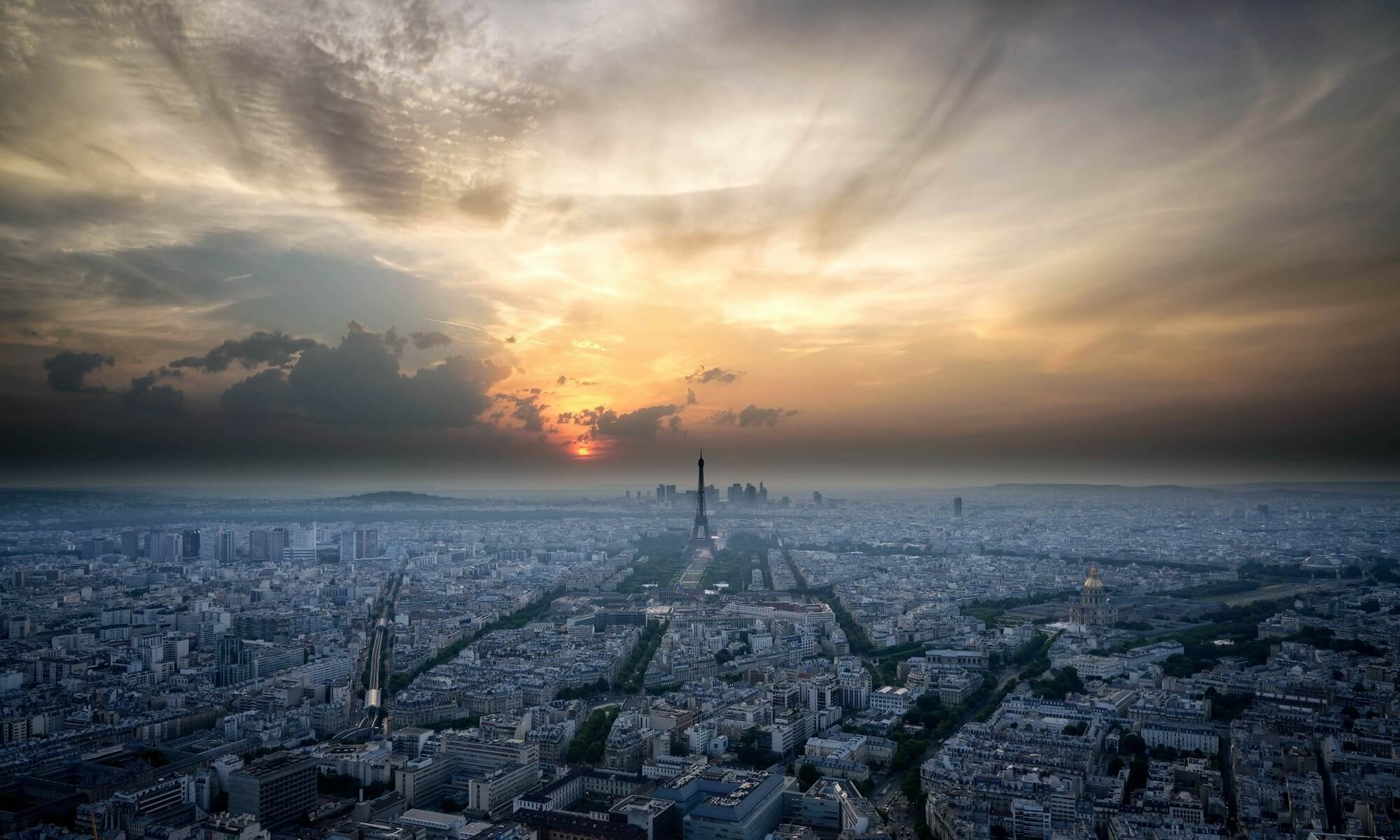Table of Contents for this Episode
Categories: Toulouse, Toulouse Area
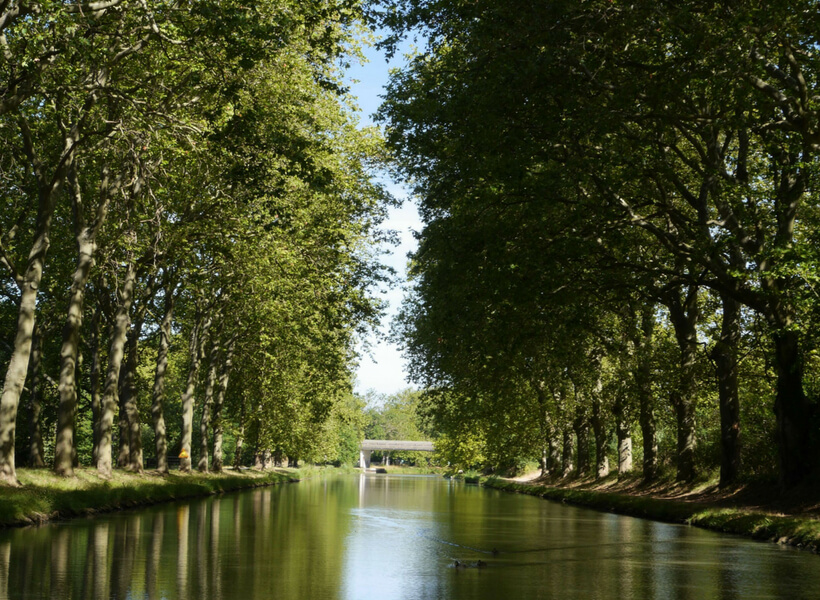 What is the Canal du Midi?
What is the Canal du Midi?
The Canal du Midi is a major site when it comes to the history of southwestern France. The Canal du Midi originates in the city of Toulouse which is that center between the Atlantic and the Mediterranean. Approximately 100 km from the Pyrenees as the crow flies, and basically landlocked. There is a large river in Toulouse called the Garonne which starts in the Pyrenees and flows northwest towards the Atlantic in the city of Bordeaux, in the estuary called the Gironde. The word Midi refers to the south of France in this case, that in another context, the word “midi” also means noon. When talking about the Canal it simply means the canal of the South. The canal starts in Toulouse and goes towards the Mediterranean. It does not go towards the Atlantic.
Why did they build this Canal?
Long ago, it was very difficult to export goods from the area of Toulouse towards other major trading routes. It was possible to take goods from Toulouse to Bordeaux on the Garonne River but this is a river that floods a lot. Starting with the Romans who settled all of Gaul and had major cities in the east and south of France, there was a strong interest in doing commerce.
Romans wanted to import and export from various parts of their empire. To do so, they used the many rivers that are found in France. But rivers tend to flood and also dry out at various times of the year. This causes the problem for river transportation. Back then, France had very dense, very large forests that were filled with wild animals, brigands, and all sorts of dangerous people. So if goods made it to Bordeaux on the Garonne River they had to be loaded onto ships, then down the coast of Portugal, through the Strait of Gibraltar, all the way up through Spain, just to be delivered to other parts of the Roman Empire.
That was a long way to go. There are three things that are a problem: spoilage, pirates, and later on taxes that Spaniards imposed on anybody who wanted to go through the Strait of Gibraltar. So shipping used to cost a fortune and always took a long time. So this situation made things difficult for the Romans. Even the great Roman engineers could not solve this puzzle, so they gave up on it.
Landlocked Southwest of France
The Southwest of France stayed closed in for a long time because of the lack of easy transportation. Goods produced in the Southwest stayed local. And even when Toulouse became part of the kingdom of France, to get to Paris goods had to go up the Garonne River and be transferred by boat up the Atlantic Coast. Eventually the few land routes were developed between Toulouse in Paris to be used by carriages and horses, but it didn’t work easily for textiles, ceramics or wheat. There were canals for irrigation, but nothing big enough for navigation.
From the Romans until the 1300s in the 1400s nothing was found to facilitate commerce in this area. There was a series of Kings who thought opening up this area to commerce would be very good, so they kept sending engineers to the Southwest to look for a solution. These engineers knew where they could place a waterway for navigation, but they did have a solution that would keep it from flooding and from drying out. Their idea was to connect one River to another, not to construct the canal. They were imagining running one River into another, but they knew it probably would not work so they did not invest in it.
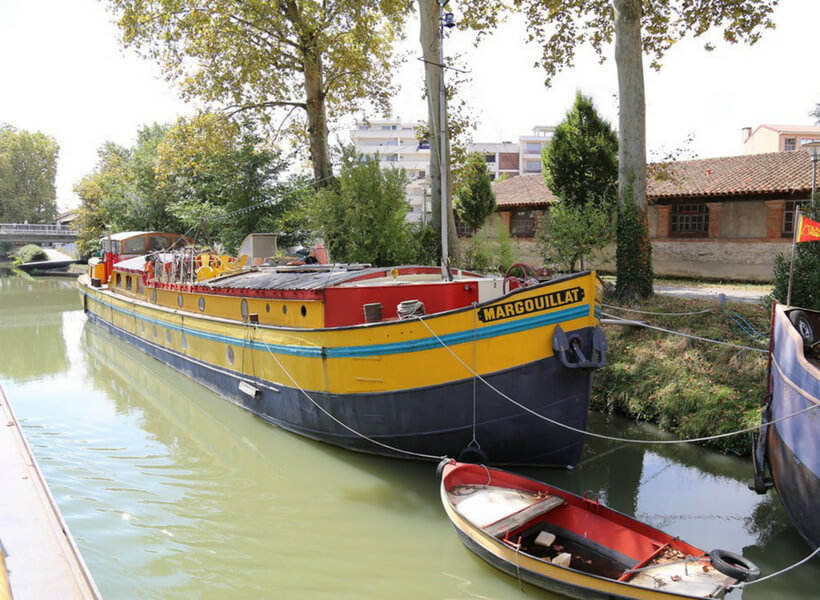
Engineering Problem
Then came the Renaissance (1500s, 16th century) which was a fabulous entry for new ideas. King François I who was a major Renaissance man and who was the first one to bring scientists into this project, but when the engineers take a look at it they explain why it still won’t work. By the end of the 1500s, there is a group of people in the Southwest who are for the most part amateurs and minor nobleman, and they form a club of people who were trying to figure out how to open up this area. They are geeks who want to solve the problem and make a lot of money. They employ the best engineers they can find and by the end of the 1600s technologies are developing.
The Riquet Family
And one of these men looking for a solution is called Riquet. He is a minor nobleman from the town of Béziers. He comes up with a plan, and they sent to the king Henry IV, and the King again says no it’s not going to work. This man Riquet dies, but he has passed on this passion for finding a solution to his son whose name is Pierre Paul Riquet. Pierre Paul Riquet was born in 1606 in Béziers and he inherits from his father both his title and his function which was to be a tax collector.
At that time, it was a given that, the tax collector would steal about 20% of whatever he could collect. Pierre Paul Riquet was the tax collector on salt and the salt tax was called the gabelle (http://en.wikipedia.org/wiki/Gabelle_of_salt). But his passion was to find a solution for opening up the landlocked areas of the Southwest of France.
He was an amateur engineer. As a boy he accompanied his father and these other man when they traveled throughout the Southwest looking for a solution. Pierre Paul Riquet started to think about where he could find a good source of water that could be never ending. This is the point where they stopped trying to connect different rivers and thought about building something new.
Building something meant a lot of money, and a lot of manpower. By the time Pierre Paul Riquet is 50 years old, he thinks he has come up with a solution. He was married and had six children, and two of his sons also had worked with him on this project. Unlike his father, Pierre Paul Riquet pursues this as his personal project.
He consults engineers and other technical people, but otherwise works alone. In the year 1652 he buys a piece of land which can visit today, it has an old fortified château on it, it is called Bonrepos, it’s 15 km outside of Toulouse, on top of a hill. The land is around 50 acres, and the reason why it’s interesting to him is that it’s very similar to areas around the black mountain further east.
He wants to build a miniature version of the project he has in mind on his own land. He is going to test his ideas which is brilliant. He builds to basins which he fills with water, having bought the water rights to a small river for a total of six years. He creates a system of small canals (“rigoles”), but these are not open air, they are closed in like a pipeline.
The Continental Divide
Everybody knew that there is a Continental divide in the Southwest of France. This is a spot where on one side the water naturally flows west and on the other it naturally flows east. In North America the Continental divide is in the Rockies which are very large mountains. But in France it’s in an area with a hill of 172 m. The water that flows north to south naturally divides to the east and to the west.
Pierre Paul Riquet artificially built something like that on his land so he could test it. He also had to have the ability to add water into the system for drought times. He did not work out on a map exactly where each part of the canal should go. He simply wanted to prove that he had a system that could feed water into a canal.
Riquet Writes to Louis XIV and Colbert
Louis XIV is interested in two things: getting as much money as he can from this project, and sticking it to his cousin the King of Spain. By this time the King of Spain is making tremendous amounts of money was all these vessels going around the Strait of Gibraltar and the Spanish controlled the seas. Colbert was Louis XIV’s finance minister and he’s the one who will be used in very treatable you only work you see the present hope you and your family is you want anybody to sort is already known here as it is Riquet sense documented evidence of how is going to implement this project. The idea was to build a canal between Toulouse and the Mediterranean and then connect it to the Garonne River in Toulouse to give access all the way between the Atlantic and the Mediterranean. In that way they could stick it to the King of Spain.
The area of Toulouse produces a lot of wheat, and silk, and ceramic, and textiles, as well as wine. The King looks at the project, discusses it with Colbert who is very skeptical. Louis 14th sends Royal engineers to Toulouse seeking proof that this will work. They are seeking 17th century proof of concept. The engineers a very impressed with what they see.
In the meantime Riquet had built the basin north of the Continental divide to show that he could feed water into the system both going East and West. The alternative England has lost had in the legality said there was like you as you a engineers go back to the King and tell him that they think this could work.
Financing the Canal du Midi
Louis XIV has very little money left in the treasury, because it all went to the building of the Château Versailles, so he works out a deal with Riquet. The King will put up a small percentage of the initial monies necessary, the region “L’état du Langudoc”also agreed to finance part of the project, and Riquet would have to come up with the rest of the money out of his own personal fortune. In exchange, Riquet gets the concession. The King agrees, and Riquet now owns the concession to the duties paid for the use of the canal.
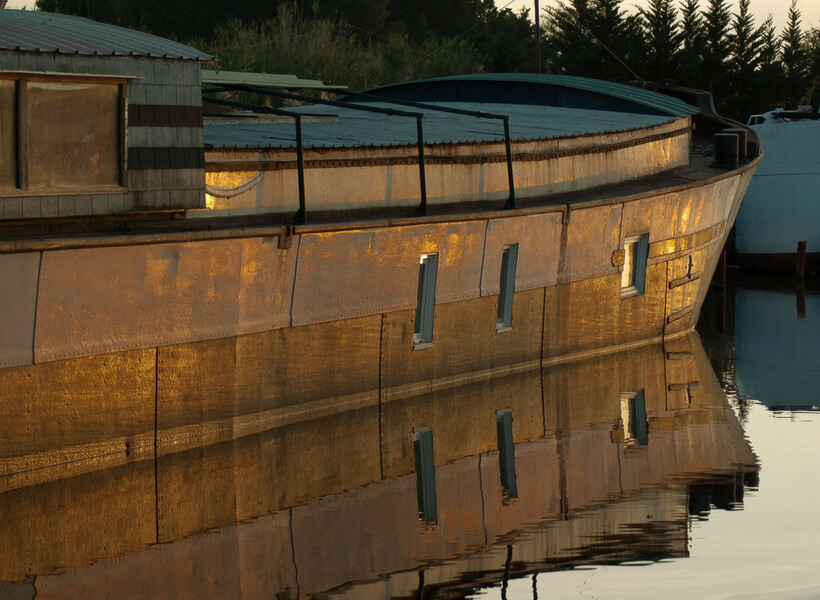
The Construction of the Canal du Midi
They start working on the canal in 1666 and finish it in 1681. It is 241 km long which is 160 miles. The first stretch of the canal goes between Toulouse and the town of Trèbes, just on the other side of Carcassonne. The reason why the canal stops at Trèbes is that the people who run the city of Carcassonne in the 1600s refused to have the canal stop there. Eventually they were sorry about that, and added a section of canal to go to Carcassonne.
The official opening of the canal was in November 1682, so we consider the canal took 16 years to build. In that 16 years 12,000 people, both men and women, worked on the construction of the canal. Riquet died in May 1681, six months before the inauguration of the canal. He was already 71 years old at the time, his oldest son who was responsible for a lot of the work was by his side when he died, he had exhausted himself trying to finish the project, and they say that his last words were is it finished yet?
The change in altitude or elevation is 182 m altogether. That is not very much but it does cause problems with the flow of water. There are a total of 65 locks on this canal. On the western side between Toulouse and where the waters divide there are only 17 locks, but between the Continental divide (Seuil de Naurouze) and the Mediterranean there are 48 locks. There are seven canal bridges which were invented for this canal. These are bridges where the canal and its water flows over the bridge. It’s like an aqueduct with boats on it. There are areas where there are eight or nine locks all in a row.
Most important engineering achievement of the 17th century in Europe
The Canal du Midi has been named the most important engineering achievement of the 17th century in Europe. There was a very important military engineer named Vauban who built all kinds of forts all over France. The King sent Vauban to the Canal du Midi after Riquet’s death, after the inauguration, to see if everything was properly built. It turns out that there were problems. Some of the structures, including the reservoir of Saint-Ferréol, were not strong enough and had to be reinforced. In spite of that, what Riquet achieved was fabulous. Not only did he find a solution to a problem that had existed for 1600 years, but he also was a leader in terms of social reform.
Riquet, the Great Social Reformer
Riquet both men and women to dig out the canal. They were digging with picks and shovels, so this was physically taxing. But Riquet built homes for the workers, Inns, and restaurants. He also paid them twice the going rate. These were, for the most part, poor people and modest farmers who lived in the various places where the canal went. Instead of using forced labor, he got people to come work for him because his wages were good, this was in the 1600s and he gave them vacation pay, he gave them sick leave, he paid them extra if they had to work on Sundays, and he encouraged people to work in the section of the canal where they came from so they didn’t have to travel very far.
Riquet had very modern ideas, he wanted new housing all along the canal where the workers could stay after the canal was built. He didn’t really accomplish all of that, but he tried. Word got out to all the aristocrats in the area of how much Riquet was paying his workers when they were still exploiting serfs and they complained to the King. In the end, he continued to pay his workers more, but not twice as much, and he did give them a lot of benefits that nobody else had. A third of the people who worked for him were women which was unheard of. He turned out to be a major benefactor for the Southwest of France.
Impressive Achievements
People were astonished to see the work that was done. He created triple rounded basins to allow boats to moor, there are canal bridges which were entirely new, but he also opened up the area for trade. Before the Canal du Midi it took two or three months for goods to move from the Toulouse area to the Mediterranean because they had to go up the Garonne River and all around Portugal and Spain. With this Canal du Midi it only took three days. Immediately it was used for mail, for shipping goods, and from day one, it was used for tourism and travel. It was safe all of a sudden to travel through the Southwest. No more going through woods, dealing with bandits, and wild animals. Traveling along the Canal du Midi was both safe and fast.
The Second Section of the Canal du Midi
They started working on the second section in 1673 and finished in 1682. That section goes between the city of Trèbes to the Mediterranean. The Canal du Midi opens to the Mediterranean at a place called the Etang de Thau. The city of Sète was started for the Canal du Midi. Today Sète is a nice size city, but at the time it was a small fishing village. The port in Sète was built in conjunction with the Canal du Midi so that the goods that arrived on barges could be put on bigger ships to navigate the Mediterranean and eventually go up the Rhône River, or go further East to Italy.

The Junction Between the Garonne River and the Canal du Midi
The switch between the Garonne River and the Canal du Midi happens in Toulouse. But there is something a little strange about that. Riquet was a genius, he figured out a solution to a problem that was centuries-old. There were two things he didn’t think of, and to this day people wonder about it. He knew that he wanted to start in Toulouse, because it was a major commercial center in the Middle Ages.
The Garonne River, which cuts through the middle of Toulouse, it’s a capricious River. It floods, there are sections were just cannot go with the boat, even flat bottomed boat. There is an area of the Garonne River in the city of Toulouse where the water is very shallow. It’s a natural fjord in the river. Both Riquet and the Kings engineers miscalculated and the Canal du Midi stops not at the river, but a mile away. So it was easy to put goods on the Canal du Midi and take them to the Mediterranean. If you want your goods to go between Toulouse and the Atlantic, you put them on the Garonne River. From 1680 until 1770 the only way to do that was to unload everything and load up again in my later.
Étienne-Charles de Loménie de Brienne
Loménie de Brienne wanted to figure out a way to stop this nonsense. He did a lot of work to help Toulouse move from the ancient Middle Ages to the era of the Enlightenment in the 1770s. He found the funds to build a canal that’s exactly a mile-long called the Canal de Brienne which connects the Canal du Midi to the Garonne River.
Many Names for the Same Canal
At the beginning, the Canal du Midi was called the Royal Canal of Languedoc in honor of the King. Then during the French Revolution the canal was renamed the Canal of the People of the Republic of France. Then, soon after the French revolution, in the 1800s, Napoleon called it the Napoleon Canal. He did that to everything! In 1848 it went back to being called the Canal du Midi, and that is what it is called today.
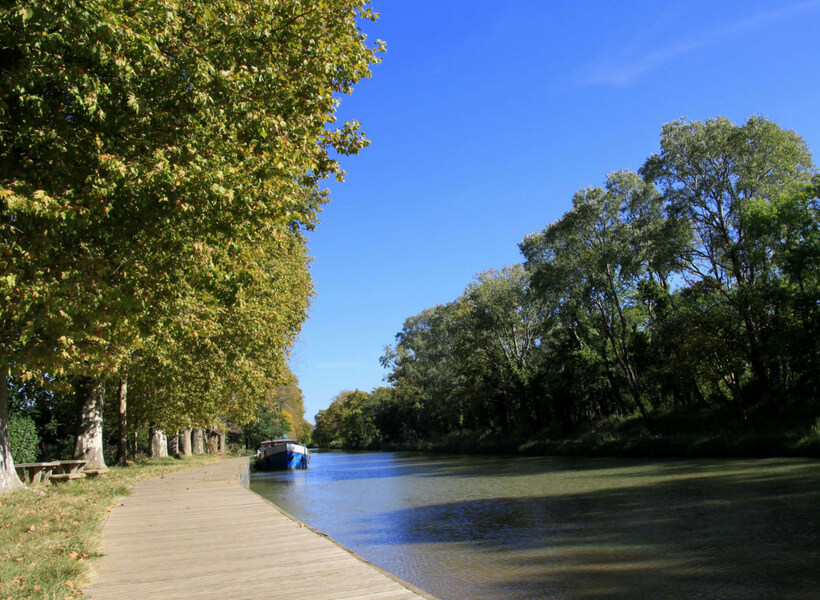
Ownership of the Canal du Midi
The King had to use part of his own fortune to pay for the building of the Canal du Midi. The estimate for the cost was 6 million pounds, but the final cost was actually 18 million. Riquet borrowed against his fortune and his wife’s fortune. It was not until the time of his grandchildren, 50 years later, that they started making some significant money and stopped paying back the debt that the family had incurred to build this canal.
So the canal started to be profitable in the 1730s after which the family became incredibly rich and it remained profitable until 1789 time of the French revolution. The French revolution confiscated the canal and took it away from the Riquet family. In 1858 Napoleon the third (who is the nephew of the original Napoleon, who has come into power for a short period of time) decides to take the concession of the Canal du Midi and turn it over to the train company (chemins de fer).
The train company decides that they don’t need the canal because by then there are trains all over France. At the beginning of the 1900s there is only wine tray going on the Canal du Midi, and by the first world war the Canal du Midi is not used anymore. The Canal du Midi brought vibrant business to the Southwest of France for 250 years, but it is really the small Canal. It is only 2 m deep and at the widest it is 20 m wide, so it is not large enough for big barges. Canal systems built after the Canal du Midi in France feature much wider canals, and some of those are still used for commercial purposes.
The Canal du Midi Today
The Canal du Midi never dried out, but there are problems with the accumulation of silt. Every year it is closed for two months in the winter so that it can be dredged. Since the second half of the 20th century it has been used for pleasure boats. There are barges that you can rent. There are short excursions that you can do on the Canal du Midi for an hour or two. Or, and this is very popular, there are approximately 10,000 people who do this every year, you can rent a boat that will sleep five or six people. They teach you how to manage the boat in a few hours, and you can rent it for a week at a time. Most people take bicycles also, they more in various villages and basins, and they go explore on their bicycles. It makes for a slow and easy summer vacation.
Horses and Trees on the Canal du Midi
In the olden days, horses were pulling the barges. As a result, there are wonderful pathways all along the Canal du Midi. You can write a bicycle all the way between Toulouse and the Mediterranean along the Canal du Midi. There are beautiful trees all along the canal and they were necessary to shape the canal and reduce evaporation and also to give the horses some shade.
At times, it was people pulling the barges along the canal. There were always several thousands of these horses working along the canal. When the canal was built, there were 45,000 trees planted, and by the time of the French revolution there were 100,000 trees along the canal. At the beginning, they planted poplars and willows.
By the end of the 1700s they had planted a lot of mulberry trees because this region had a strong silk industry and the used the mulberry leaves to feed the silkworms. The silk industry died out at the time of the French revolution, and they started planting a different type of Poplar called the Italian Poplar, and in the middle of the 1800s they planted the Plane trees that we have there now. The Plane tree belongs in the family of the sycamore trees. In French those are called “platanes”. Motorized barges were introduced in the 1930s, but they were still using horses up until the 1970s. The last horse was in the 1980s.
Thomas Jefferson and the Canal du Midi
Thomas Jefferson came to Toulouse in 1789 to study how the Canal du Midi work. At the time he was the ambassador of the United States to France. He wrote a letter to George Washington to say that he thought it would be a good idea if they used the same system to connect the Potomac in Washington DC to Lake Erie. That’s a very large distance and it never happened. They did build a canal on the Erie, but nothing like the original plan.
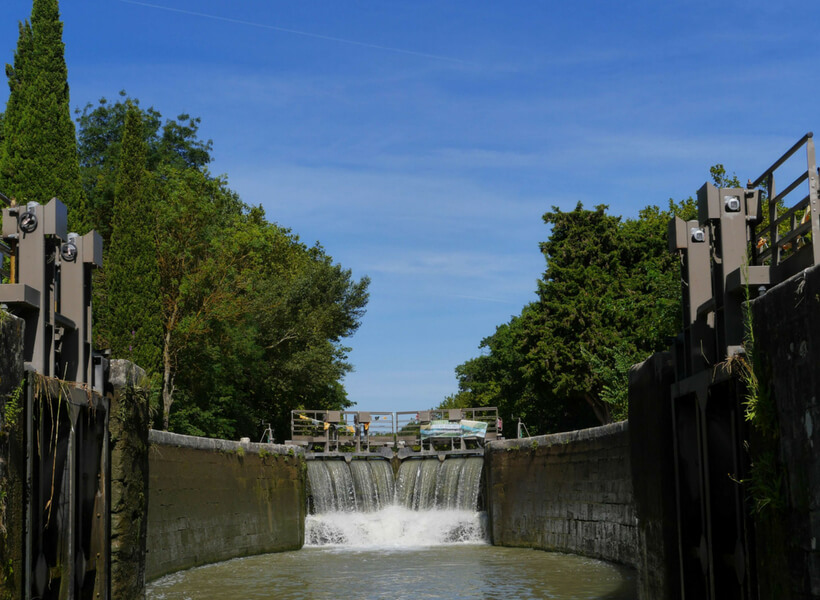
UNESCO World Heritage Site
In 1996 the Canal du Midi became UNESCO world heritage site. It is labeled as one of the major building projects of the 17th century for all of Europe. Riquet is considered to be a hero. There are two things that you can do when you visit this area. One is to take a ride along the canal, you can ride a bike, or run, or walk, or rent a boat. The other thing is you can go and visit the Château Bonrepos which was recently bought by the village that it’s in, and you can see where Riquet did his experiments. There are still big barges along the canal, but nowadays it’s mostly prettier smaller boats designed with cabins inside, they are quiet boats.
Locks on the Canal du Midi
It’s fun to go see how the locks work because the third of him and still the original mechanical locks. There are still people who live in houses where the locks are and it’s their job to open and close them. Or, sometimes, people have to jump out of the boat and go open the lock. When the canal was finished, they were chapels along the way, there were Auberges and restaurants, there were houses, there was even prostitution going on. Nowadays it’s a very nice place to walk the dogs.
One problem is that the mountain bike people are just crazy and go by superfast, you can’t hear them coming, so it’s starting. Joggers are much easier to deal with. Another thing you can do is “Camping à la ferme” where you can put a On somebody’s land for the night if you get permission. There are also people who bring their canoes and canoe along between two locks. There is some freshwater fish in the canal but you don’t usually see people fishing, they also have muskrat living along the banks.
Conclusion
There are fancy cruises along the Canal du Midi where you have a crew of two people doing your meals and driving the boat, but more often on this particular canal it said families or groups of friends who rent a boat and do it all themselves. It’s like camping but on the water. But even if you don’t take time to do that, you should at least go look at the canal when you come visit the Southwest of France, it’s very scenic and pleasant.
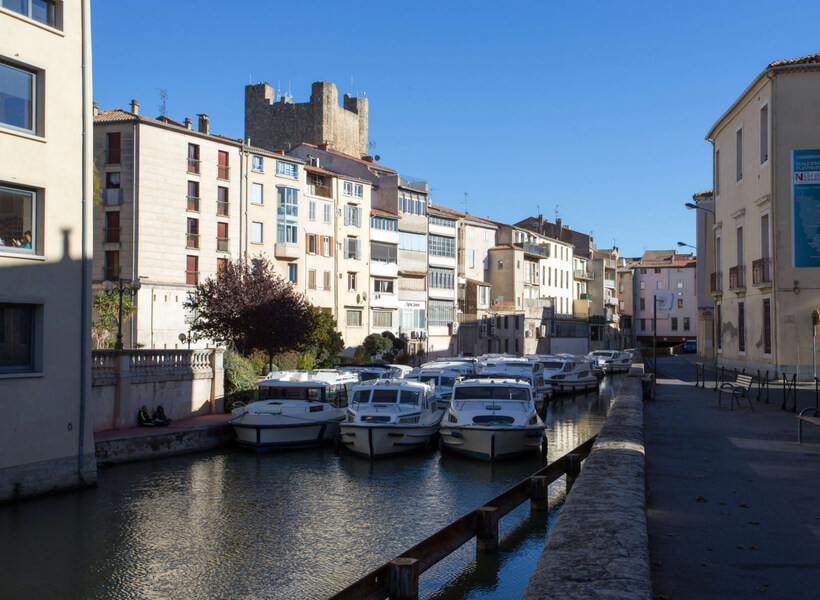
Subscribe to the Podcast
Apple YouTube Spotify RSSSupport the Show
Tip Your Guides Extras Patreon Audio ToursRead more about this transcript
Episode PageCategories: Toulouse, Toulouse Area
